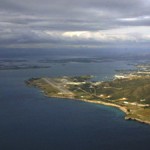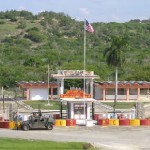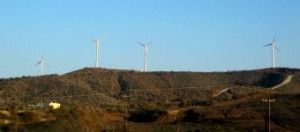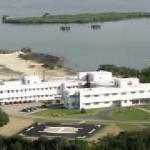THE GUANTANAMO BAY, CUBA
Called “GITMO”
Guantanamo, Cuba is a town in the province of Oriente, situated near the head of the most important harbor east of the city of Santiago on the southern coast. The bay is a pouch-shaped indentation about 12 miles long in a northeast-southwest direction and about 6 miles across at its greatest width. Guantanamo Valley, a low, hilly district, extends westward from the bay along the Sierra Maestra. The deep bay is sheltered by the nearby Cuzco Hills (elevations to 495 ft) to the south and east and by mountains to the north.
Guantanamo Bay has been famous as the scene of important actions in the Spanish American War. On 19 May, 1898 an unsuccessful attempt to cut the cable in the bay was made by the USS SAINT LOUIS and the USS WOMPATUCK. On 10 June a force of 600 Marines landed from the transport USS PANTHER on the eastern shore of Guantanamo Bay and undertook to make the outer harbor a secure place for the use of U.S. Vessels when coaling or as a rendezvous and a refuge in stormy weather. The marines established their camp on a small hill, where they sustained attacks of Spanish troops for several days with courage and endurance. The USS MARBLEHEAD and the USS TEXAS lent assistance by landing small forces of marines and then these and other ships supported the land operation with naval gunfire. When ten days had passed, the outer harbor was practically in the possession of American Forces.
http://youtu.be/jWpOTMyAJKk
In July 1901 the U.S. Government selected Guantanamo Bay as the site for a naval station and in 1903 the land on both sides of the entrance was leased from the Cuban Government. Guantanamo Bay is the largest harbor on the south side of the island and is surrounded by steep hills creating an enclave cut off from its immediate hinterland. The base is about 400 air miles from Miami, Florida.
The United States assumed territorial control over the southern portion of Guantánamo Bay under the 1903 Cuban-American Treaty, which granted it a perpetual lease of the area. The United States, by virtue of its complete jurisdiction and control, maintains “de facto” sovereignty over this territory, while Cuba retained ultimate sovereignty over the territory. It is the oldest overseas U.S. Navy Base, and the only one in a country with which the United States does not have diplomatic relations. The agreement was forced on the new Cuban government, and gave the U.S. navy permission to occupy the bay. On December 12, 1903. Official control of Guantánamo Bay is “handed” to the U.S. in a ceremony on the battleship Kearsage. At noon on that day the Cuban flag is lowered and the American flag is raised. Only one Cuban is present at the ceremony.
In December 1903, the United States leased the 45 square miles of land and water for use as a coaling station. A treaty reaffirmed the lease in 1934 granting Cuba and her trading partners free access through the bay, payment of $2,000 in gold per year, equating to $4,085 today, and a requirement that both the U.S. and Cuba must mutually consent to terminate the lease. After the Platt Amendment was annulled in 1934, a new lease was negotiated between the Roosevelt administration and a Cuban government that included Fulgencio Batista as one of three signatories. Batista emerged as the strong man on the island over the next twenty-five years.
The issue of returning Guantánamo to Cuba is complicated by the agreement signed by Batista in 1934. The agreement states: “Until the two Contracting Parties agree to the modification or abrogation of the stipulations of the agreement in regard to the lease to the United States of America of lands in Cuba for coaling and naval stations… the stipulations of that Agreement with regard to the naval station of Guantánamo shall continue in effect.” To the U.S. this means an “open-ended duration” that can only be terminated by mutual agreement. To Cuba it means that Guantánamo Bay is “occupied territory.”
The Naval Base facilities were expanded tremendously just prior to and during World War II, and today Naval Operating Base, Guantanamo Bay, Cuba is the major U.S. naval installation in the Caribbean. U.S. diplomatic relations with Cuba were cut on January 3, 1961 by President Dwight Eisenhower; shortly prior to John F. Kennedy’s inauguration on January 20, 1961. At that time, many Cubans sought refuge on the base. U.S. Marines and Cuban militiamen began patrolling opposite sides of the base’s 17.4 mile fenceline. Today, U.S. Marines and Cuba’s “Frontier Brigade” still man fenceline posts 24 hours a day.
In October 1962, family members of service people stationed here and many base employees were evacuated to the United States as President John F. Kennedy announced the presence of Soviet missiles in Cuba. This was the start of the Cuban Missile Crisis which resulted in a naval quarantine of the island until the Soviet Union removed the missiles and US promised not to invade Cuba. The evacuees were allowed to return to the base by Christmas 1962.
Another crisis arose just 14 months later on Feb. 6, 1964, when Castro cut off water and supplies to the base in retaliation for several incidents in which Cuban fishermen were fined by the U.S. government for fishing in Florida waters. Since then, Guantanamo Bay has been self-sufficient and the Naval Base desalination plant produces 3.4 million gallons of water and more than 800,000 kilowatt hours of electricity daily.
In May 1994, Operation ‘Sea Signal’ began and the naval base was tasked to support Joint Task Force 160, here providing humanitarian assistance to thousands of Haitian and Cuban migrants. In late August and early September 1994, 2,200 family members and civilian employees were evacuated from the base as the migrant population climbed to more than 45,000 and the Pentagon began preparing to house up to 60,000 migrants on the base. The last Haitian migrants departed here Nov. 1, 1995. The last of the Cuban migrants left the base Jan. 31, 1996.
In March, 1996, the fate of Guantánamo took another sad turn when it was incorporated into the Helms Burton Law authored by the anti-Castro community and signed into law by President Bill Clinton. Section 201 (12) of Chapter II modifies the existing 1903/1934 treaty so that “the duration of the base,” as explained by Olga Miranda in her essay How To Exit the Guantánamo Treaty, “will now depend on whether Cuba has a government that Washington approves of.”
According to Miranda, the Helms-Burton provides “further proof that the continued existence of the naval base in Guantánamo is imposed on Cuba by the United States with no legal backing whatsoever and without consideration for the will of the Cuban people.”
In early 2005, four white wind turbines began operating John Paul Jones Hill, the base’s highest point, named after the Revolutionary War naval hero. The turbines, standing at 80 meters (262 feet) high, feature three-blade turbines. The four turbines were estimated to provide as much as a quarter of the base’s power generation during the high-wind months of late summer and fall; an appreciable fact given that Guantanamo Bay is completely self-sustaining, generating its own power and water without having to rely on Cuban municipal sources. In addition to generating power, the turbines have significantly cut down on emissions of greenhouse gases created through burning diesel fuel.
Since 2002, the naval base has contained a military prison, the Guantanamo Bay detention camp, for persons alleged combatants captured in Afghanistan and later in Iraq. The alleged mistreatment of all prisoners, the proven mistreatment of some prisoners, and their denial of protection under the Geneva Conventions, has been a source of international controversy.
After 52 years of service, Guantanamo’s Fleet Training Group relocated to Mayport, Florida, in July 1995. One month later, the naval base lost another major tenant command when the base’s Shore Intermediate Maintenance Activity disestablished after 92 years of service.
While this media-blog will not attempt to enumerate the many legal aspects of international law invoked by this “lease”, it’s important to note that most other territories occupied by other nations have been returned. The Panama Canal was returned to Panama in January 2000, Hong Kong was returned to China by the United Kingdom in 1997, and Portugal returned Macau Island to China in 1999.
Since 1959, the U.S. sends a check for the lease amount every year, but the Cuban government has never cashed them.
Sources: Wiki/USDocumt/CubaDocumt/InternetPhotos/Youtube/TheCubanHistory.com
History: The Guantanamo Bay,Cuba /The Cuban History/ Arnoldo Varona, Editor






